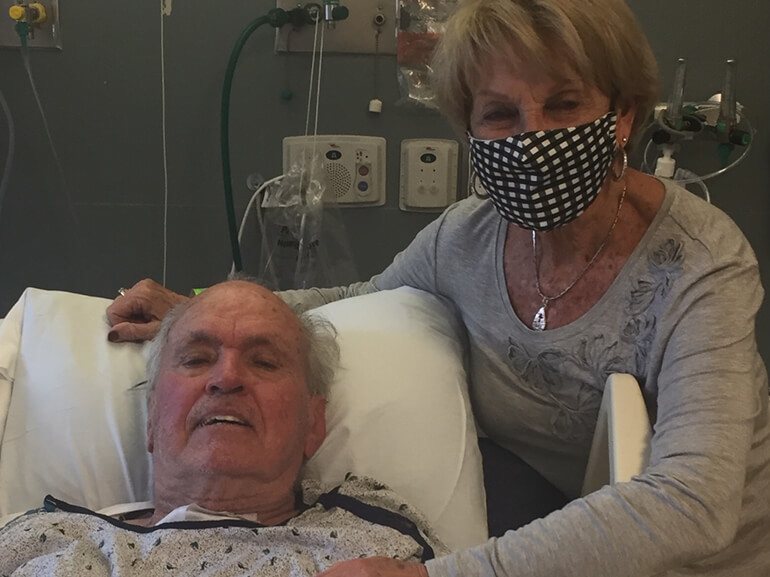Bill Young's story

In their 59 years together, Bill and Jane Young have faced formidable challenges, but none as threatening as Bill’s dual diagnosis of COVID-19 and Guillain-Barre Syndrome.
The couple came down with the virus and started treating symptoms at home. Jane’s were manageable. But as Bill’s battle continued, a new set of problems emerged for the 80-year-old retired principal and school administrator. His feet ached and walking was difficult. By the third day, Bill couldn’t move.
Jane called 911 and an ambulance rushed him to the local hospital’s emergency room. Following a battery of tests and tenuous wait in the ER due to the hospital’s influx of COVID-19 patients, Bill was admitted and diagnosed with Guillain-Barre Syndrome – a neurological condition in which the body’s immune system attacks the nerves.
To avoid further complications, Bill was sedated, intubated and connected to a ventilator. Intravenous immunoglobulin treatments, which send healthy antibodies from donated blood to fight the malfunctioning ones, began, as did IV antibiotics for pneumonia and a bloodstream infection. Later, airway support and a feeding tube were placed.
Bill stabilized a month later. Awaking from the medically-induced coma, only his eyes and head could move. Yet, there was reason to hope – feeling returned to his toes.
The hospital’s case manager recommended Select Specialty Hospital – Wilmington for the next step in care. Jane and the couple’s two daughters, Wendy and Stacey, had never heard of a critical illness recovery hospital. After several conversations and many questions, they chose to send Bill there.
Short-term, Bill wanted to walk and breathe independently. Long-term, he hoped to get back to being the active outdoorsman and grandfather he’d always been – taking his Labrador Retriever, Finn, and grandson, Beckett on hunting trips and attending sports and academic performances for his three other grandkids.
A physician-led team, including nurses and therapists, created a plan to bring Bill back to all the things he loved.
Respiratory therapists began gradually dropping the amount of machine-provided support, testing whether Bill’s lungs were strong enough to work on their own. Within three weeks, he was fitted for a special collar allowing freer breathing and valve permitting more normal speech. The family mailed Bill an Amazon Echo so he could voice-dial home any time. Soon, Bill was able to call and speak to the family for the first time in almost two months.
Simultaneously, physical and occupational therapy began a mobility program. At first, he needed full assistance to turn in bed.
Through stretching, resistance and range of motion exercises, his limbs regained movement. As strength built, Bill rolled side to side and sat bedside while maintaining balance with minimal assistance. Therapists taught him how to transition to a wheelchair and use his arms to propel down the hall with help.
Visitation restrictions in place to safeguard patients and staff from COVID-19 prevented family from visiting, but they made sure Bill didn’t miss much. In coordination with staff, they brought a laptop so he could watch a livestream of his granddaughter’s lacrosse game. His walls were papered with cards and pictures from family, friends and neighbors.
A month and a half after arriving, Bill was strong enough to have airway support removed and returned to independent breathing.
Speech was something Bill was eager to get back. Treatment focused on oral motor and breath-strengthening exercises to improve swallowing and speaking ability.
The speech therapist joked that for a principal, he was a terrific student – he even asked for extra “homework” to work on later. For fun, the speech therapist graded each session, with Bill almost always earning an A.
In cooperation with dietitians, they also worked on transitioning from a thirst-quenching spray mist to ice chips then water. After passing a safe-swallowing study, a pureed diet was introduced.
After two months, Bill was ready for the next step in care. He moved to an inpatient rehabilitation hospital to continue building strength and skill in daily living activities following his double-barreled diagnosis.
Grateful for the care received and his survival, Bill is confident he will return to his beloved family soon.